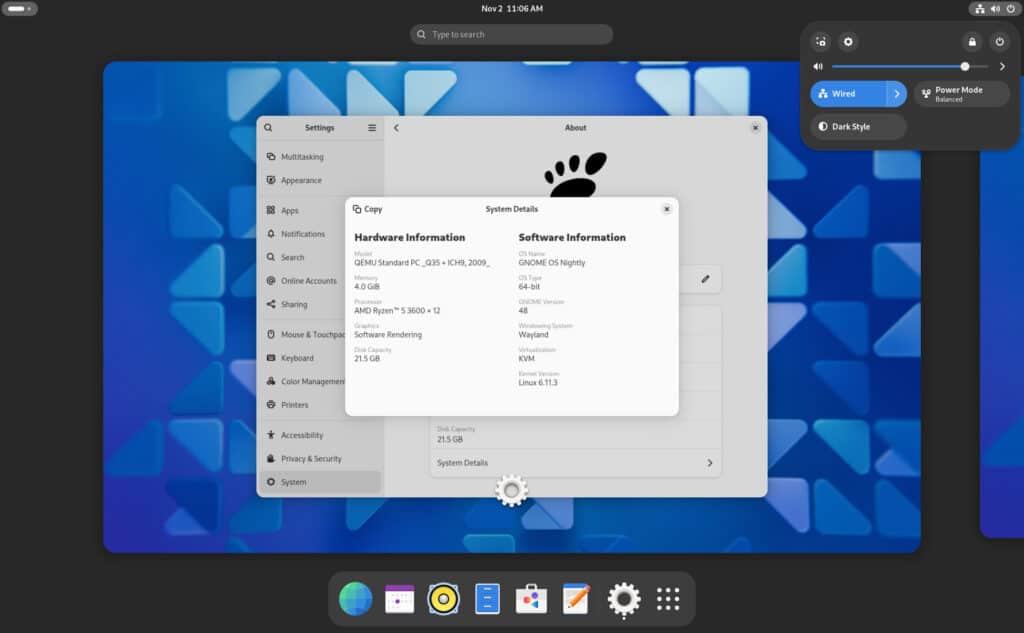As I write this, I can’t shake off a sense of déjà vu. And it couldn’t be otherwise, given that just yesterday, I published almost the same news, with the same concept behind it, about a new distribution using the same under-the-hood technologies. Namely, about the KDE developers’ project to create their distribution called (well, are you surprised) KDE Linux.
Now, we’re seeing a similar idea emerge, but this time, it is about the other leading desktop environment (come on, System76, give us COSMIC finally), GNOME. As you’ll see in the following lines, this “coincidence” is anything but random. But let’s start a little further.
A year ago, Sovereign Tech Fund invested a staggering €1M as a work commission in GNOME to improve various aspects of the desktop environment. One of these is the implementation of home directory encryption, which is being worked on by the GNOME Foundation’s contracted developer, Adrian Vovk.
The name may be familiar since this is the same guy who birthed carbonOS, an immutable distribution with a clear mission: to make the Linux Desktop accessible to users without requiring them to be tech experts.
After years of development, it became evident that his vision aligned well with GNOME OS’s future possibilities. This led to a major decision—discontinuing carbonOS as an independent project (before even reaching its first stable release) and contributing directly to GNOME OS.
After recently attending the annual KDE world summit, Akademy, where plans for KDE Linux were unveiled, being a GNOME-oriented developer, Vovk decided to pursue a similar goal with GNOME OS. He aims to develop it into a fully functional operating system tailored to everyday Linux users’ needs.
For those unfamiliar, GNOME OS is a development and testing ground designed primarily for developers to test and showcase the latest desktop environment’s features. It includes only the essential components needed for the GNOME desktop environment to function, as it’s not intended to be a full-fledged Linux distro for everyday users.

But why GNOME OS? According to Vovk, it offers the perfect foundation for a general-purpose Linux system that anyone can use, from tech-savvy enthusiasts to everyday computer users. He truly believes that the GNOME Desktop’s simple and clean interface, paired with its technical direction, makes it the ideal environment to achieve this vision.
So, what would a user-first GNOME OS look like? Vovk shared a glimpse into the blueprint:
- Flexibility and an Opinionated Approach: GNOME OS will aim to work across multiple form factors—desktops, laptops, tablets, and even phones—while easily adapting to specific hardware. It will also take an “opinionated” stance, reducing the number of decisions users need to make to avoid overwhelming those unfamiliar with technical nuances.
- GNOME Desktop: The OS should use a stock GNOME environment, keeping it simple and reducing confusion by sticking to the default GNOME applications. This approach ensures that users experience the core GNOME philosophy, which prioritizes simplicity and coherence.
- Flatpak for Apps: Flatpak will be the backbone of app distribution. Flatpak’s cross-distro nature will help break barriers between Linux distributions and make it easy for users to explore a broader ecosystem.
- Immutable: GNOME OS aims to be reliable, minimizing risks of accidental damage. Users should be able to roll back easily if anything goes wrong, especially after updates. By making each OS copy identical, and where the core system files are locked and cannot be modified or overwritten during regular use —a concept known as immutability—debugging becomes simpler, and users no longer have to deal with individual misconfigurations.
- Security and Modern Technologies: Vovk emphasizes the importance of security, with plans to utilize platform features like UEFI Secure Boot and TPM to improve privacy and user convenience. Modern technologies like Wayland, Pipewire, and XDG Portals will also be at the heart of GNOME OS to ensure a cutting-edge user experience.
So far, so good. But building a full-fledged operating system is a monumental task. And unlike the KDE initiative with KDE Linux, the case of Vovk, to me personally (with all due respect), seems like a one-man show for the moment. And practice has proven that without community support, such projects rarely achieve their goals in practice.
Let’s hope, though, that the development will be positive and that the idea will not repeat carbonOS’s fate. As always, we will keep you informed as any developments occur. Until then, you can check out Vovk’s plans to turn GNOME OS into a full-fledged Linux distro on his blog.

Gnome? No thanks, not as long as there is Cinnamon, KDE, LXDE, Mate, and Xfce.
Seriously? Didn't we spend a very painful decade learning that this doesn't work? Even the 800 pound gorilla of Windows figured out that it's a bad idea.
When I turn on my computer, I want it to look like a computer, not like a phone or a Mac.
I think what Windows did was try to emulate mobile interfaces on the computer, which was a terrible decision. I think there is benefit to UI consistency across platforms, though, which is the success of Apple. A Macbook has a computer's interface and functionality, but does so with the Swift design language
Oh great, yet another distro. yay…
Hello! Thanks for the article. Slight corrections:
– I didn't attend Akademy. I just watched their KDE Linux talk and saw the positive community reactions. So I decided to make the end-user GNOME OS plans public. As I mentioned in the blog, we've been discussing this inside of GNOME for over a year
– It's not a one-man show. carbonOS was a one-man show. Part of the reason I'm rebasing on GNOME OS is because it has a team of maintainers working on it, and has had this team since before I started working on Linux even. GNOME OS is the same source code as the GNOME Flatpak Runtime, so it's decently well maintained.
Thanks so much for the clarification, Adrian.I just wanted to add that we're genuinely excited to see this idea take shape, and you can count on us to be among the first to publish a review when it's live with GNOME OS. Thank you for the effort you're putting into this project, and of course, fingers crossed – we root for your success!
I thought it was KDE Neon? And what about Vanilla Gnome?
KDE Neon, while potentially usable as a daily driver, is not actually intended to be.You could consider it a more stable KDE equivalent to the current GNOME OS.
In fact, there can be instability problems in Neon due to using Ubuntu LTS as a base, e.g. when a KDE component needs newer libraries than Ubuntu provides.
KDE Linux (code name: "Project Banana") on the other hand, would be a from-scratch distribuition tailored to running KDE software.
I can't comment on Vanilla Gnome since I don't know the project.
Well, not precisely "from scratch." It'll use Arch as a base.